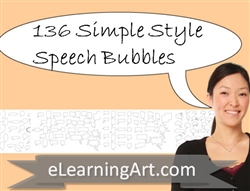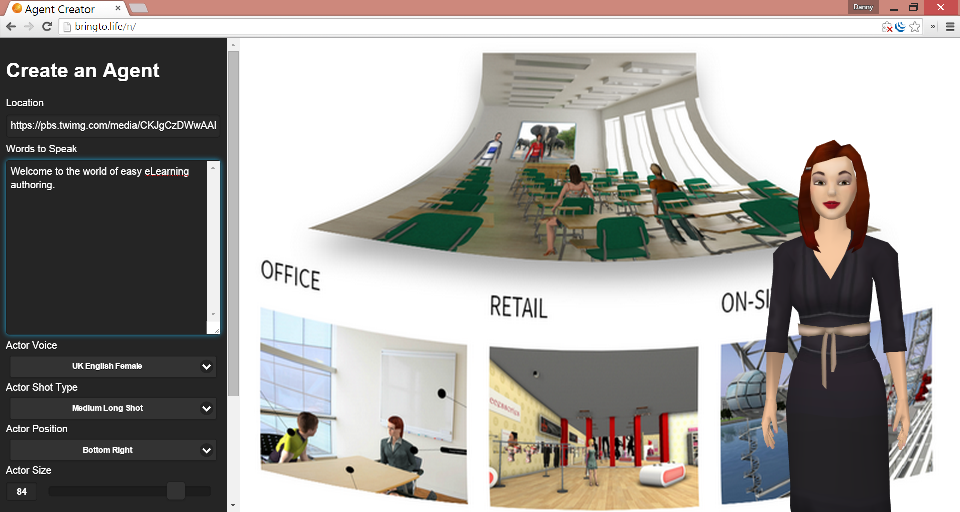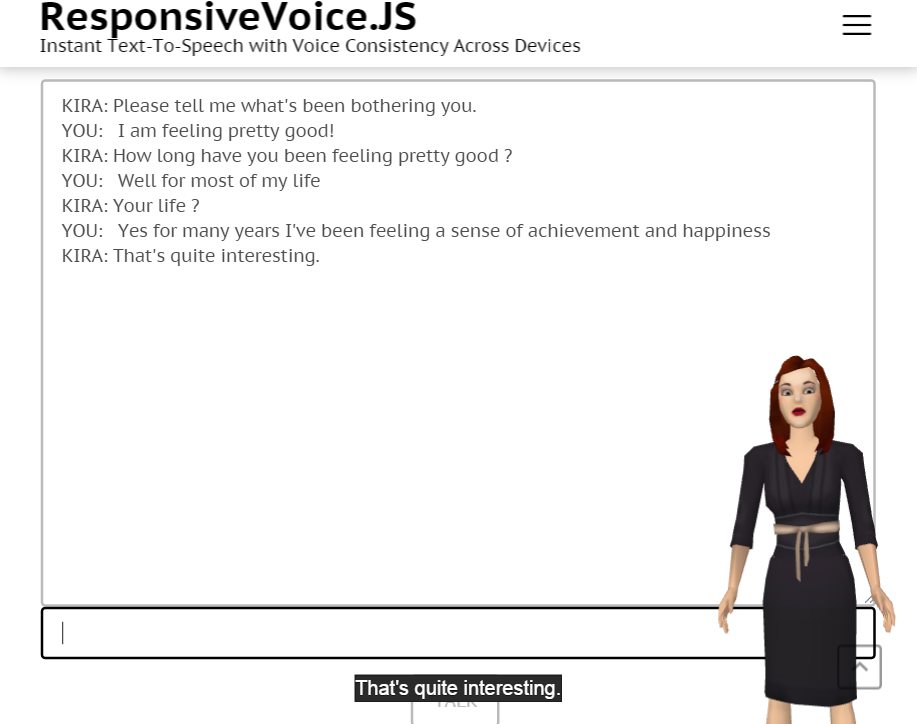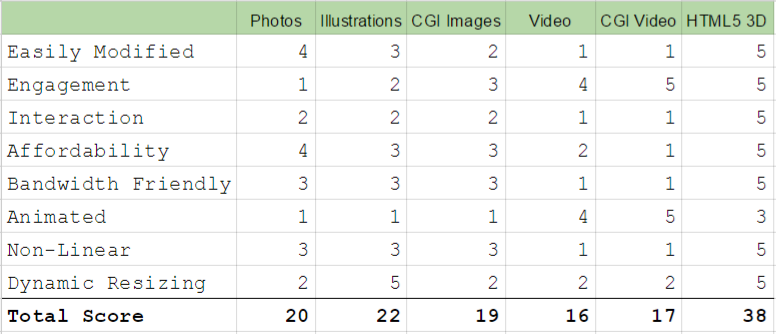The learning industry is going through a time of change in which computers are replacing traditional learning methods. ‘Millennials’ are engaging and shaping the eLearning process so that it becomes about so much more than reading online books or “next, next, quiz” slideshows. Whereas face to face or instructor led training creates a bond between teacher and student, this is often absent in eLearning. Stronger engagement in eLearning is possible by applying the same techniques used in computer games, games that today’s elearning audience have grown up with. One key element of this bond, that has been present in games now for 30 years is the avatar; the following is a brief overview of the potential role of the avatar in eLearning.
The idea of an avatar in eLearning has been constantly evolving, from the first slideshows to add the image of a presenter with speech balloons to today’s built in features in popular authoring tools to add “cut out people” with a choice of static poses for expression.

Fig 1. Speech Bubbles – eLearningArt.com

Fig 2. Static Poses – eLearningBrorthers.com
Another popular alternative is to use videos embedded in slides of a spokesperson.
Or if you have the budget a rendered video of a 3D animated character.
Avatars can be narrators, facilitators, characters, storytellers, game officials, trainers, teachers or whatever you want them to be; for the purpose of this explanation we refer to them generically as avatars. They solve the biggest problems in eLearning, of creating the level of fun and engagement that millennials need to stay ‘tuned-in’. They may not be quite as good as humans, but they have been good enough for computer gamers for the last 30 years.
Cut out people, either photos or illustrations have become the defacto standard for many eLearning companies as they can deliver a basic sense of character interaction and be easily authored without the need for a programmer or videographer or a 3D animator. Additionally this approach allows for making modifications far more easily than having video re-shot or 3D re-rendered. The downside is of course that you only have a set of static images that may change pose, this looks very much like a powerpoint or older style slideshow presentation and can fail to meet the expectations of today’s learners.
Watching hollywood science fiction movies we are tempted with the ideas of a fully present Artificial Intelligence that can communicate with us freely, become our guide, our teacher and seems to show interest in our progress.
We are not quite at the hollywood dream yet! But we are on the way with some breakthrough technologies that are now available in today’s HTML5 web browsers.
The technologies include 3D through WebGL, animation with JavaScript and Speech Synthesis through the Web Speech API; all part of HTML5 and available in all modern browsers.
However all the best technology in the world is of little use unless eLearning authors can produce avatars as simply and easily as they have been doing, otherwise we likely face a barrier to adoption and the reign of cut out people will continue to the detriment of learners who crave a more compelling and interactive experience. In the internet world we call this User Experience Optimization, creating value through engagement.

Creating HTML5 avatars is now the easiest and most cost effective way to create characters for eLearning. Through http://BringTo.Life all an author has to do is choose a background (or leave it transparent) enter the “Words to Speak” and a talking animated mobile- and desktop-ready character is available to paste into your chosen eLearning authoring tool.
Avatars can be ‘intelligent’ virtual teachers delivering eLearning via a person-like conversational interface. An avatar can be the teacher for any course, the guide to content, the expert who asks or answers the questions, the reassuring voice of your customer service organization.
How Do They Look?
Avatars can be programmed with unique roles, appearances, fashion, or uniforms.
With cut out people there are selections of preset characters to choose from in popular elearning template sites and within tools like Articulate Storyline, Adobe Captivate and Lectora Inspire.
Of course you can always photograph your own which can add cost. Alternatively engaging an illustrator to draw vector graphic avatars in different poses and expressions makes it easier to request changes, rather than organizing another photoshoot under the same conditions (clothing, recording setup, voice and lighting).
Shooting video or employing 3D film makers can create amazing and engaging results but you’ll need to get it right first time around or risk incurring delays and dramatic costs to re-shoot or re-render. The amount of expression available in video and the emphasized expression available in CGI film is the best quality available, your characters can look as you choose.
How can they speak?
Speech bubbles
The easiest way to have an avatar communicate is a speech bubble appearing in an elearning presentation, it is silent, the learner reads the text. This style reminiscent of cartoons adds a warm and comical flavour to eLearning.
Online slide text
Another common method is simply having the avatar with a pose that suggests they are speaking the text on an eLearning slide, this allows the author to write in a more personal manner which engages the learner far more than slabs of impersonal informational text.
Text to Speech
Breathing life into avatars can be achieved easily with real time voices to guide the user through the learning process. By using ‘text to speech engines’, questioning conversations can be continually created and recreated to keep avatars updated at the lowest cost and time. For a fuller and more permanent speech, when everything has been tested in text to speech a professional narration can become the voice of an avatar. Text to speech creates perfect output in over 60 languages so avatars can overcome the language barriers in distributed education. It is possible to customise avatars and even superimpose the face of any individuals on to a similarly built and dressed avatar for a more personalised learning experience.
Using ResponsiveVoice and HTML5 text to speech can be created at runtime without having to pre-record mp3/wav files, making TTS an even more attractive option for ease of authoring.
Professional Audio Narration/Voice-Overs
The highest quality and but also the most costly and least flexible for changes is professional narration.
How They Know What to Say?
Avatars can guide learners to successful outcomes, connect them to the right learning resource, and even facilitates evaluations all with easy to use learner centered self-service.
The avatar can become as intelligent as you want it to be. There is a trade off between ease of authoring, engagement and interaction.
Typically the easiest approach is to have the avatars speak slide text or text in speech bubbles. Leaving users to read the text is fairly unengaging. Adding text-to-speech or professional narration dramatically increases engagement.
Personalization
An easy way to increase the perception of a more intelligent agent is to add personalization, for example having the avatar speak the user’s name engages the user and makes the training feel tailored for them. This is guaranteed to pleasantly surprise the learner and grab their attention.
Slide Triggers
Another way to create engagement through interaction is by having the avatar respond to actions taken by the learner. For example change what is said based on triggers such as a mouse-over event on a slide or the selection of an item in the page or scene.
Branching Non-Linear Scenarios
Avatars can be provided with their ‘artificial intelligence’ by using non-linear dialogue and branching conversations.

Branching dialogues can create simple and effective dynamic feedback where questions and content lead in the direction the course intends to go, but the learner has the ‘illusion of freedom’ in approaching the course content in the order they wish or even that a ‘game’ lets them.
In the past a programmer was typically needed to design branching scenarios. But these days branching scenarios can be designed by writers and instructional designers using authoring tools such as Chat Mapper.
Adaptive Training Content
With the following types of interaction we are moving into the realm of developers which increases the cost and complexity of designing learning outcomes. This is however a field undergoing massive change, and one day soon a breakthrough will allow for non-programmers to start building intelligent agents for eLearning.
For example through the use of analytics such as xAPI, avatars actions can be based on learner reaction, ensuring your virtual assistant stays relevant and engaging.
Simple AI
Engines using AIML (Artificial Intelligence Markup Language), Alice, Eliza, or front ends to a powerful corporate knowledge bases and their related search capabilities provide a way to ask an avatar questions and have information returned and spoken. Such an assistant could site alongside traditional elearning presentations to augment and provide ondemand information. Allowing a learner to take a tangent and dig deeper into a topic of interest. In the future such an agent might be available for all corporate knowledge, on-demand and mobile.
This link shows what happens when you link an Avatar to a simple artificial intelligence brain.

http://responsivevoice.org/responsive-avatars/
Complex AI
Hollywood AI may be just around the corner, with natural language processing, understanding meaning, the ability to respond, and the capacity to build a rapport by profiling the learner. Currently it takes a talented team and a committed investment to build with these tools to create good results.
Whatever the brain you choose for your avatars, the good news is if chosen wisely you can upgrade their capabilities over time and take advantage of future technologies as they become economical and available.
Engagement and Interactivity
Avatars offer an experience which learners may well find more embracing than static slideshows, they are the closest thing to talking to humans we have available today. The more they can react and respond to the learner the more engaging they will become. Elearning does not need to be an effort or a task, it can be enjoyable and fun and something learners desire to return to. Dynamic avatars combined with gamification techniques are a potent combination for the engagement of future learners.
Quality Resizing and Cross Platform
Avatars can be used on cross platform devices in HTML5 and webGL to deliver engaging self-service platforms for learners to navigate, ask questions, and get exactly what they need. Learners can speak with avatars through text and the avatar can delivers instant, accurate, and successful outcomes in a natural, human-like way.
Back of the Napkin Summary
Let’s take a look at the different options we’ve discussed for creating avatars and estimate their rate based on how easy they are to modify, how engaging they are, if they support interaction, how expensive they are.

HTML Avatars are here now because the technology is available and the millennials have devices that run Android and iOS so are not bound to the desk or the training room. They provide a layer of fun and engagement to the education of millennials that they have enjoyed for a lifetime in games. They are a key ingredient in making eLearning more fun and engaging and you will see their rise in prominence during the coming years.
